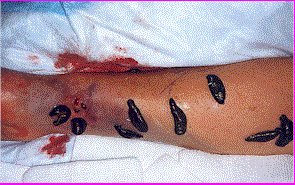Say that word aloud and you get the idea of a leech.
L-E-E-C-H. What pops into your head? A blood-sucking, slimy, dancing, drunk, black worm, correct?
Exactly what it is.
Leeches are segmented worms or anelids, cousins of the earthworms. The wonderful part about leeches is they have suckers at both ends. They are sanguivorous, which means they feed on blood of other animals.
A leech detects its prey by sensing movement and light. To imagine the way it moves, just think of a flexible tube with two plumber suckers at each end, dancing like a slinky down the stairs.

The usual jungle leeches you find on rainy days in Malaysian forests (the jawless leeches or Rhyncobdellida) don't have jaws to bite, instead, they have this needle-like protusion called a proboscis (like butterflies for nectar), which they inject into one of our skin pores, and happily begin to drink. They inject an anti-coagulant hirudin, which floods the wounded pore, helping the leech to relax and allow the blood to be ingested.
According to www.austmus.gov.au/factsheet/leeches :
There may also be a delayed irritation and itching after a bite. There appears to be no support for the theory that mouthparts left behind after forced removal of the leech causes this reaction. Can leeches transmit disease? There is no evidence to suggest that they do.
Leeches have been known over the centuries to be used for medical purposes. In fact, pharmacies nowadays supply leeches to hospitals and clinics! They put leeches on the body part which has been infected, and in a very literal sense, the leech will suck out all the bad blood.
Shown here below is the process of decompression for a woman who had forearm hematoma. And which the leeches helped return her arm to its normal state, all pink and flexible.
